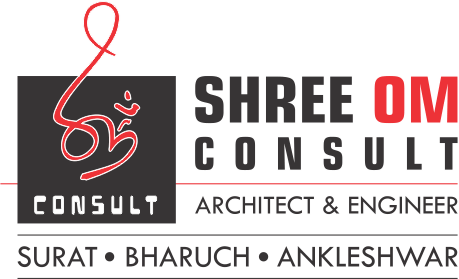
Building Sustainable Futures: How SOC Integrates Eco-Friendly Design in Residential and Commercial Projects
As the world moves toward more responsible and mindful living, sustainability has become an increasingly important part of architectural design. In an era when environmental impact is at the forefront of social concerns, the need for eco-friendly and energy-efficient buildings has never been greater. Shree Om Consultant (SOC), an innovative architectural business with locations in Surat, Bharuch, and Ankleshwar, is a forerunner in the use of sustainable design concepts. Shree Om Consultant (SOC),takes a proactive approach to each project, creating places that not only suit the requirements of the present but also contribute positively to the future of our world.
Key Strategies in Eco-Friendly Design
1. Energy-Efficient Building Orientation
Shree Om Consultant (SOC) highlights the significance of building orientation in optimizing natural light and ventilation. By properly arranging buildings to capture sunlight, they eliminate the need for artificial lighting, lowering energy usage. Well-placed windows and shading devices assist control temperature, lowering the need for air conditioning and boosting building energy efficiency. This intelligent strategy keeps buildings pleasant while lowering energy expenditures over time.
2. Use of Sustainable Materials
Incorporating eco-friendly building materials is central to Shree Om Consultant (SOC)’s design philosophy. Sustainable materials such as recycled steel, bamboo, reclaimed wood, and low-VOC (volatile organic compound) paints help reduce the environmental impact of construction. These materials are durable, versatile, and often locally sourced, which minimizes transportation emissions and supports the local economy. Moreover, the use of non-toxic materials contributes to a healthier indoor environment, promoting the well-being of residents and workers alike.
3. Integration of Renewable Energy Sources
Shree Om Consultant (SOC) actively incorporates renewable energy alternatives, such as solar panels and wind turbines, into its designs. Solar panels are increasingly being utilized to create renewable energy for residential and commercial buildings, decreasing reliance on grid power and driving down electricity bills. Shree Om Consultant (SOC) reduces customers’ carbon footprints while also ensuring that buildings are future-ready, capable of responding to the rising need for green energy solutions.
4. Water Conservation Techniques
An additional essential element of sustainable design is water saving. Shree Om Consultant (SOC) uses techniques such as rainwater collection, greywater recycling, and low-flow plumbing fittings to minimize water use. These technologies enable buildings to reuse water more effectively, which in especially significant in areas with limited water resources. Rainwater harvesting systems gather rainwater for non-potable applications such as landscaping, while greywater recycling allows water from sinks and showers to be recycled for irrigation, further lowering the building’s dependency on municipal water sources.
5. Green Landscaping
Shree Om Consultant (SOC)’s designs often feature green spaces that promote biodiversity and provide natural insulation. Green roofs, vertical gardens, and native plant species are incorporated into many of Shree Om Consultant (SOC)’s projects, creating eco-friendly environments that contribute to reducing urban heat islands, improving air quality, and enhancing the aesthetic value of the space. By choosing drought-resistant and native plants, Shree Om Consultant (SOC) ensures minimal water usage for landscaping, reducing the need for irrigation and contributing to overall sustainability.
6. Sustainable Waste Management
Shree Om Consultant (SOC) understands that waste management is a critical part of sustainability. From construction to day-to-day operations, waste management systems are implemented to minimize landfill contributions. Incorporating waste sorting and recycling systems, they ensure that valuable resources are reused, reducing waste generation. This responsible approach to waste management not only benefits the environment but also encourages the community to adopt sustainable practices.
Shree Om Consultant (SOC)’s experience in sustainable design makes them a top choice for real estate developers looking to fulfill contemporary environmental regulations. Their collaborative approach guarantees that sustainability is smoothly integrated throughout the project lifecycle, from design to completion. Shree Om Consultant (SOC) collaborates closely with developers to understand the project’s goals, budget, and environmental requirements, ensuring that eco-friendly elements are integrated without sacrificing design quality or functionality.
Commitment to Continuous Learning
Shree Om Consultant (SOC) engages in constant learning and training to be up to speed on the newest green building certifications and sustainable technology. To keep up with current developments in sustainable design, their team attends industry conferences, workshops, and seminars on a regular basis. This devotion guarantees that their designs stay inventive and in line with worldwide sustainability standards, allowing them to preserve their position as leaders in eco-friendly architecture.
Conclusion
Creating a sustainable future demands a collaborative approach, and architecture companies play an important part in this process. Shree Om Consultant (SOC) demonstrates how deliberate design and environmental stewardship may coexist to create structures that are both practical and eco-friendly. As the globe shifts toward greener solutions, Shree Om Consultant (SOC)’s commitment to sustainable design puts them as pioneers in creating a better tomorrow. By incorporating energy-efficient solutions, sustainable materials, renewable energy sources, and water conservation techniques, Shree Om Consultant (SOC) ensures that its projects not only meet today’s needs but also have a long-term, positive impact on the environment for future generations.

0 comments